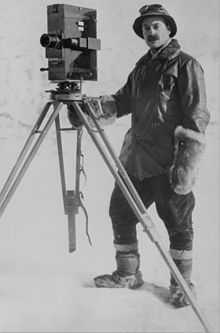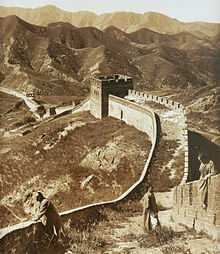Herbert Ponting

Herbert George Ponting, FRGS (March 21, 1870 – February 7, 1935) was a professional photographer. He is best known as the expedition photographer and cinematographer for Robert Falcon Scott's Terra Nova Expedition to the Ross Sea and South Pole (1910–1913). In this role, he captured some of the most enduring images of the Heroic Age of Antarctic Exploration.
Early life
Ponting was born in Salisbury, Wiltshire in the south of England, on 21 March 1870. His father was a successful banker, Francis Ponting, and his mother was Mary Sydenham.[1] From the age of eighteen Herbert was employed at a local bank branch in Liverpool, where he stayed for four years. That time was long enough to convince him that he did not wish to follow in the profession of his father, and attracted to stories of the American West, he moved to California where he worked in mining and then bought a fruit ranch in the 1890s. In 1895 he married a California woman, Mary Biddle Elliott; their daughter Mildred, was born in Auburn, California in January 1897.

After the ranch failed in 1900, Ponting took up free-lance photography seriously. Following a chance meeting with a professional photographer in California, to whom he had given advice about the locality and showed his own photos, he entered his pictures in competitions and won awards. He took successful stereoscopic photographs. In 1904 he was living in Sausalito, north of San Francisco. He reported on the Russo-Japanese war of 1904–05, and afterwards continued to travel around Asia, working in Burma, Korea, Java, China and India as a freelance photographer for English-speaking periodicals. Improvements in the printing press had made it possible, for the first time, for mass-market magazines to print and publish photographic illustrations.[2] Ponting sold his work to four of London's foremost magazines, the Graphic, the Illustrated London News, Pearson's, and the Strand Magazine. In the Strand, Ponting's work appeared side by side with the Sherlock Holmes stories of Arthur Conan Doyle, one of Ponting's contemporaries.
Ponting expanded his photographs of Japan into a 1910 book, In Lotus-land Japan. He was elected a Fellow of the Royal Geographical Society (FRGS). His flair for journalism and ability to shape his photographic illustrations into a narrative led to his being signed as expedition photographer aboard the Terra Nova, the first time a professional photographer was included on an Antarctic expedition.
The Terra Nova and Antarctica
As a member of the shore party in early 1911, Ponting helped set up the Terra Nova Expedition's Antarctic winter camp at Cape Evans, Ross Island. The camp included a tiny photographic darkroom. Although the expedition came more than 20 years after the invention of photographic film, Ponting preferred high-quality images taken on glass plates.
-

Scott's ship Terra Nova
-

Scott at Cape Evans base
Ponting was one of the first men to use a portable movie camera in Antarctica. The primitive device, called a cinematograph, could take short video sequences. Ponting also brought some autochrome plates to Antarctica and took some of the first known color still photographs there.
The expedition's scientists studied the behavior of large Antarctic animals, especially killer whales, seals, and penguins. Ponting tried to get as close as possible to these animals, both on the Terra Nova in the sea ice and later on Ross Island, and narrowly escaped death on one occasion in early 1911 when a pod of eight killer whales almost knocked him and his camera off of an ice floe into McMurdo Sound.
During the 1911 winter, Ponting took many flash photographs of Scott and the other members of the expedition in their Cape Evans hut. With the start of the 1911–12 sledging season, Ponting's field work began to come to an end. As a middle-aged man, he was not expected to help pull supplies southward over the Ross Ice Shelf for the push to the South Pole. Ponting photographed other members of the shore party setting off for what was expected to be a successful trek. After 14 months at Cape Evans, Ponting, along with eight other men, boarded the Terra Nova in February 1912 to return to civilization, arrange his inventory of more than 1,700 photographic plates, and shape a narrative of the expedition. Ponting's illustrated narrative would be waiting for Captain Scott to use for lectures and fundraising in 1913.
Later life
The catastrophic end of "Scott's Last Expedition" also affected Ponting's later life and career. When the Terra Nova had sailed south in 1910, it had left massive debts behind. It was expected that Scott would return from the South Pole as a celebrity and that he could use moving images from his expedition in a one-man show. Ponting's cinematograph sequences, pieced out with magic lantern slides, were to have been a key element in the expedition's financial payback.
However, when the bodies of Scott and his companions were discovered in their tent on the Ross Ice Shelf in November 1912, their diaries and journals were also found. These records described the explorers' final days while suffering from exposure and malnutrition, and their desperate effort to get to a depot of food and fuel that could have saved them. Scott knew he was doomed, and used his final hours to write pleas to his countrymen to look after the welfare of the expedition's widows and survivors.
The eloquent appeals, upon publication in the British press, wrung massive donations from the public. The gifts repaid the entire cost of the expedition, provided large annuities (carefully doled out by expedition status and rank) for the widows and survivors, and left a substantial surplus for eventual use as the startup endowment of the Scott Polar Research Institute (SPRI), an affiliate of Cambridge University.
Under these conditions, Ponting's Antarctic work had become redundant. Soon afterwards, World War I began.
With the conclusion of the war, Ponting's archive drew a nibble of interest. He published The Great White South, the photographic narrative of the expedition, in 1921 which was a popular success, and produced two films based upon his surviving cinematograph sequences, The Great White Silence (1924 - silent) and Ninety Degrees South (1933 - sound). He also lectured extensively on the Antarctic. These works brought him little personal recompense, however, and his other photographic work did not go well. Ponting died in London in 1935.
The Scott Polar Research Institute purchased the Ponting Collection in 2004 for £533,000. In 2009, SPRI and publisher Salto Ulbeek platinum-printed and published a selection of the Collection.[3] The Great White Silence was restored by the British Film Institute and re-released in 2011.
In addition, one of Ponting's photographic darkrooms was reconstructed in the collections of the Ferrymead Heritage Park in Christchurch, New Zealand.
Exhibition
- 2010: Die Eroberung des Südpols – Fotografien von Herbert Ponting ("The Conquest of the South Pole: the photographs of Herbert Ponting"), Flo Peters Gallery, Chilehaus C, Pumpen 8, Hamburg, Germany.
His verse
Ponting is also the author of the humorous verse "The Sleeping Bag," which is depicted in the film Scott of the Antarctic.
THE SLEEPING BAG
Herbert George Ponting
On the outside grows the furside. On the inside grows the skinside.
So the furside is the outside and the skinside is the inside.
As the skinside is the inside (and the furside is the outside)
One ‘side’ likes the skinside inside and the furside on the outside.
Others like the skinside outside and the furside on the inside
As the skinside is the hard side and the furside is the soft side.
If you turn the skinside outside, thinking you will side with that ‘side’,
Then the soft side furside’s inside, which some argue is the wrong side.
If you turn the furside outside – as you say, it grows on that side,
Then your outside’s next the skinside, which for comfort’s not the right side.
For the skinside is the cold side and your outside’s not your warm side
And the two cold sides coming side-by-side are not the right sides one ‘side’ decides.
If you decide to side with that ‘side’, turn the outside furside inside
Then the hard side, cold side, skinside’s, beyond all question, inside outside.
Bibliography
- Arnold, H.J.P., Photographs of the World: a biography of Herbert Ponting, Hutchinson, London (1969) ISBN 978-0-8386-7959-3
- Arnold, H.J.P., Herbert Ponting: Another World, Photographs in the United States, Asia, Europe & Antarctica 1900–1912, Sidgwick & Jackson, London (1975) ISBN 0-283-98214-4
- Huxley, Leonard (ed.): Scott's Last Expedition Vols I and II Smith, Elder & Co, London, 1913 OCLC 1522514
- Ponting, Herbert G., In Lotus-Land Japan, Macmillan, London, 1910
- Ponting, Herbert G., The Great White South, or, With Scott in the Antarctic being an account of experiences with Captain Scott's South Pole Expedition and of the nature life of the Antarctic, with an introduction by Lady Scott, Duckworth, London (1921)
References
- ↑ Arnold, p. 7
- ↑ Arnold, p. 8
- ↑ "Captain Scott's Antarctic Expedition". Salto Ulbeek. Retrieved 2010-04-02.
External links
![]() Media related to Herbert Ponting at Wikimedia Commons
Media related to Herbert Ponting at Wikimedia Commons
- Scott Polar Research Institute
- Royal Geographical Society biographical tribute
- The official Royal Geographical Society print website containing a large selection of Herbert Ponting images
- BFI Screenonline on Ponting's film 'The Great White Silence'.
- National Archive on Flickr a set from the Copy archive.
- "The Lost Photographs of Captain Scott", Outside magazine, n.d. Retrieved 2013-05-18. Includes self-portrait of Ponting taking a picture of Terra Nova (#8 of 10).

